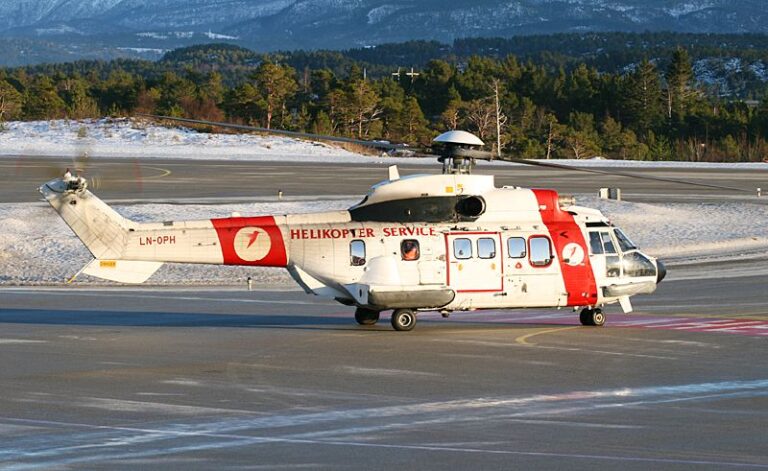In 1997, a routine helicopter flight carrying offshore oil workers ended in disaster. The crash of Helikopter Service Flight 451 remains one of the worst aviation accidents in Norwegian history.
On 8 September 1997, a Super Puma helicopter operated by Helikopter Service crashed into the North Sea while en route from Brønnøysund to the Norne oil field. All 12 people on board lost their lives.

The tragedy sent shockwaves through Norway’s offshore community and prompted widespread changes in helicopter safety, maintenance, and offshore transportation protocols.
The Flight and the Crash
Helikopter Service Flight 451 was a regular transport service carrying workers to and from offshore oil installations. On the day of the crash, the helicopter—a Eurocopter AS332 L1 Super Puma—departed Brønnøysund just before midday.
Approximately 100 kilometres off the coast, the helicopter suffered a sudden catastrophic failure. Eyewitnesses reported the main rotor blades separating from the aircraft mid-flight, after which the helicopter plummeted into the sea.
A search and rescue operation was launched immediately, involving helicopters, ships, and divers, but there were no survivors. The bodies of all 12 on board were later recovered.
Who Were The Victims?
The ten passengers on board were all oil industry workers en route to the Norne field in the Norwegian Sea. At the time, Norne was a relatively new oil development operated by Statoil (now Equinor), and the crew were heading offshore for their work rotation.
They were experienced professionals—engineers, technicians, and maintenance personnel—who were well-acquainted with the routine of flying to and from installations by helicopter.
The two pilots were also seasoned professionals employed by Helikopter Service, which was the primary provider of offshore helicopter transport in Norway during the 1990s. Both had logged hundreds of hours flying in demanding North Sea conditions.
When news of the crash broke, it hit offshore communities hard, particularly in Western Norway and the Trøndelag region, where many oil workers and their families are based.
Towns like Bergen, Stavanger, Kristiansund, and Brønnøysund went into collective mourning. Flags were lowered, and local churches opened their doors to offer space for prayer and remembrance.
In these coastal towns, almost everyone knows someone who works offshore. The tragedy was a harsh reminder that while Norway’s oil and gas industry has brought prosperity and employment, it also comes with very real dangers.

Funerals and memorial services were held in hometowns across the country. For the families, the crash was devastating. Many had seen their loved ones leave for what seemed like just another routine rotation.
The suddenness and violence of the incident combined with the inability to say goodbye left a lasting emotional scar.
The grief was compounded by the questions that followed. How could such a catastrophic failure happen? Could it have been prevented? And what would be done to make sure it never happened again?
The Investigation
In the immediate aftermath of the crash, the Norwegian accident investigation board launched a detailed inquiry into the cause of the accident.
Recovery efforts succeeded in retrieving key parts of the wreckage from the seabed, including the gearbox, which became central to the investigation.
The investigators discovered that the helicopter’s main rotor had separated from the fuselage mid-flight due to a mechanical failure. At the heart of the failure was a fatigue crack in a splined sleeve inside the main gearbox.
This seemingly small component had a critical function: transmitting power from the engines to the rotor system. When it fractured, the rotor detached, making any recovery or emergency landing impossible.
Further analysis revealed that the crack had developed over time due to a previously undetected design flaw. Tiny cracks in the metal had grown with each flight cycle, eventually leading to total failure without warning.
The manufacturer, Eurocopter (now Airbus Helicopters), cooperated fully with the investigation and issued immediate safety bulletins. As a precaution, the European aviation authorities grounded helicopters of the same model until they had undergone thorough inspection and, in many cases, replacement of affected components.
The incident also triggered a broader global review of gearbox monitoring systems, maintenance protocols, and materials used in helicopter design.
The AIBN report was stark in its conclusions: had the flaw been identified earlier, the tragedy could have been prevented. It called for a stronger focus on predictive maintenance and long-term fatigue testing in aircraft component certification.
A Turning Point for Offshore Safety
The crash of Helikopter Service Flight 451 marked a turning point in Norway’s offshore aviation sector. While the country already had relatively high safety standards, the disaster exposed weaknesses in both technical oversight and psychological preparedness.
In the months and years that followed one of Norway’s worst air accidents, sweeping changes were introduced. Operators of offshore flights were required to enhance inspection routines, particularly for gearbox and transmission components.
Manufacturers faced tougher certification requirements, and there was growing investment in technologies that could better monitor wear and tear in real time.
Beyond the technical reforms, the tragedy also drew attention to the human cost of offshore operations. Support systems for offshore workers and their families were expanded, including access to counselling services, mental health resources, and clearer communication during incidents.
Flight 451 became a reference point in Norwegian public debate, not just about aviation safety, but about the value of human life in high-risk industries.
The crash reminded the nation that even routine transport to and from oil platforms must be treated with the same seriousness as any other critical flight operation.
Remembering Flight 451
Today, Flight 451 is remembered not only for the lives lost, but for the improvements in safety that followed. In the years since, Norway has become a leader in offshore helicopter safety, with some of the world’s most rigorous standards.
Memorials were held in the affected communities, and the names of the victims are still spoken of with quiet reverence by those in the offshore industry.
While air travel to offshore installations has become safer over the years, the memory of Helikopter Service Flight 451 endures as a reminder of the sacrifices made by those who support Norway’s energy industry.
The tragedy changed the way Norway approaches offshore flight safety, ensuring that those who travel over sea for work are better protected than ever before.

